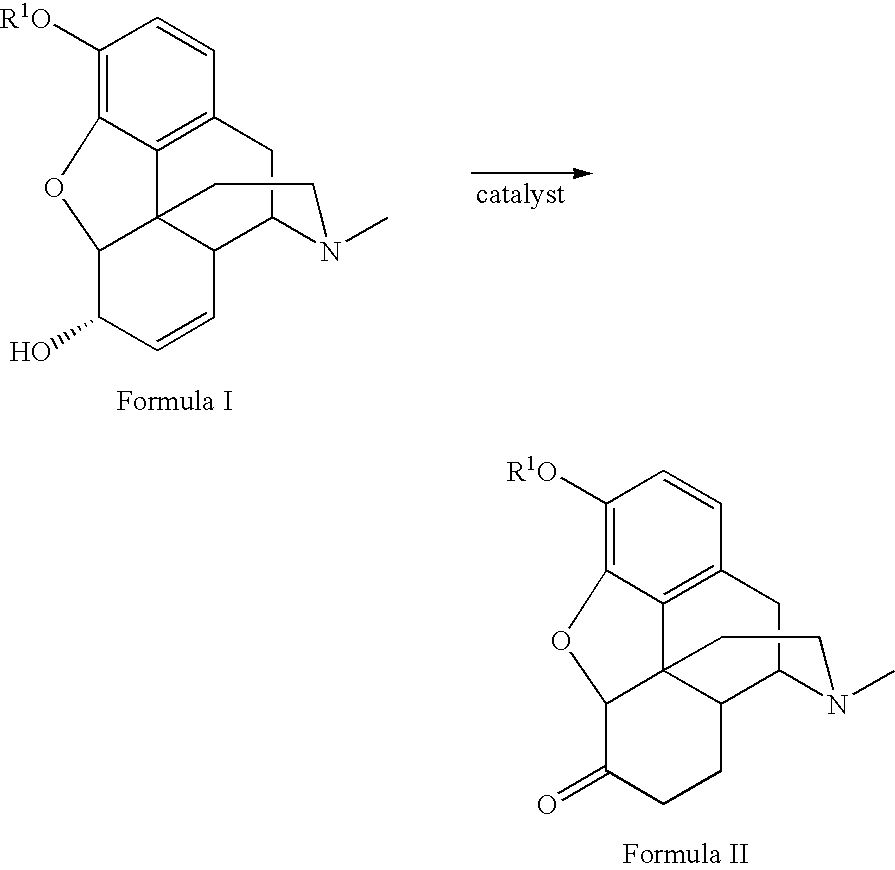Method for the catalytic production of hydrocodone and hydromorphone
a catalytic production and hydromorphone technology, applied in the field of catalytic production of hydrocodone and hydromorphone, can solve the problems of poor yield, difficult preparation of these catalysts, and high cost of methods, and achieve the effect of convenient scaling up and economical manufacturing purposes
- Summary
- Abstract
- Description
- Claims
- Application Information
AI Technical Summary
Benefits of technology
Problems solved by technology
Method used
Image
Examples
example 1
[0036] Codeine, 50.00 g, was dissolved in 200 ml methanol in a three-neck flask at room temperature. The flask was equipped with a condenser and nitrogen. The flask was flushed with nitrogen for five minutes with one neck opened. The catalyst, 0.50 g of RhCl(P(C6H5)3)3 was added to the solution. The flask was then flushed with nitrogen for another five minutes, and the open neck was closed. The reaction mixture was stirred under nitrogen and heated to reflux for four hours, then cooled to 0° C. for 30 minutes. The resulting crystals were removed by filtration. The collected crystals were washed four times with 10 ml cold methanol (5° C.), and dried in air for one hour yielding pale yellow crystals (41.50 g, yield 83%). The filtrate was pumped down to dryness to give 6.14 g yellow solid. The solid residue was dissolved in 40 ml refluxing methanol and cooled to 0° C. for 30 minutes and filtered. The collected crystals were washed four times with 3 ml portions of cold methanol (5° C.) ...
example 2
[0037] Morphine, 50.00 g, was suspended in 500 ml methanol in a three neck flask equipped with condenser and nitrogen input and outlet. After refluxing under nitrogen for five minutes, one neck of the flask was opened. A catalyst, 0.50 g RhCl(P(C6H5)3)3-was added to the container. The opened neck was closed with a stopper. The reaction mixture was stirred under nitrogen and heated to reflux for 6 hours, cooled down to 0° C. for 30 minutes, and filtered. The collected solid was washed four times with cold methanol (5° C.) and dried in air for 20 minutes. The solid was kept under vacuum (15 mm Hg) at room temperature for 1 hour, yielding a white powder (38.83 g, yield 77.7%). The filtrate was distilled under nitrogen until only 200 ml of solution remained. It was cooled down to 0° C. for 30 minutes and filtered, yielding a white powder. The product was washed twice with 20 ml each and then once with 10 ml of cold methanol (5° C.) dried in air for 40 minutes to yield 3.48 g of a white ...
example 3
[0038] Ruthenium dimer was prepared by refluxing 1 g RuCl3xH2O with 3 equivalents P(C6H5)3 in EtOH (100 ml) overnight. The resulting catalyst, [Ru(P(C6H5)3)2Cl2]2 was obtained as a black precipitate after filtration, 63% yield.
PUM
| Property | Measurement | Unit |
|---|---|---|
| mole percent | aaaaa | aaaaa |
| mole percent | aaaaa | aaaaa |
| temperature | aaaaa | aaaaa |
Abstract
Description
Claims
Application Information
 Login to View More
Login to View More - R&D
- Intellectual Property
- Life Sciences
- Materials
- Tech Scout
- Unparalleled Data Quality
- Higher Quality Content
- 60% Fewer Hallucinations
Browse by: Latest US Patents, China's latest patents, Technical Efficacy Thesaurus, Application Domain, Technology Topic, Popular Technical Reports.
© 2025 PatSnap. All rights reserved.Legal|Privacy policy|Modern Slavery Act Transparency Statement|Sitemap|About US| Contact US: help@patsnap.com



